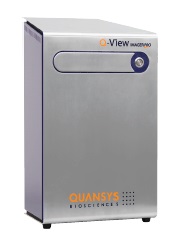
Depending on the phase where your biomarker-related research program is, imaging of protein or antibody arrays has different requirements. For R&D purposes (incl. translational and preclinical ones), a standard imager is more than enough. However, for clinical assays at the late stages, a higher resolution may be needed, especially in view of a future file submission.
Known for the development of the Q-plex platform, which is being used by translational and clinical laboratories worldwide (e.g. to detect Pneumococcus), Quansys has released a new imager, designed for higher throughput (96- and 384-well plates) and clinical-grade research.
This Q-view Imager Pro is a chemiluminiscent reader for Q-plex arrays with automation compatibility. Its cooled, high quantum efficiency sensor and clinical-grade optics are paired with advanced image acquisition algorithms which reduce noise while maximizing sensitivity to ensure higher sensitivity and high throughput data.


For those studies requiring standard sensitivity, the Q-view Imager LS is still a very valuable and affordable tool to read not only Q-plex arrays, but also Western Blots.
Interested in the new Q-view imager Pro for your clinical studies? Interested in outsourcing part of complete Biomarker discovery program to a Quansys certified European C.R.O.?
Leave a message below or contact me!


